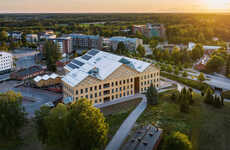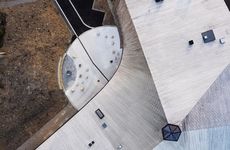
White Arkitekter Opened its Sustainable Cultural Center in Sweden
Francesca Mercurio — October 12, 2021 — Eco
References: designboom
The world's largest timber building has been completed by design house White Arkitekter and is now open to the public.
The building is home to the Sara Cultural Centre and rises 75 meters high. It is located in the Swedish city of Skellefteå and is a hotel, event space, and cultural center that boasts a sustainable design. The building is carbon-negative and is also one of the world's tallest timber towers.
Historically, the city of Skellefteå has been rich in timber architecture, and this new cultural center revives this ancient tradition while equally adopting modern building technologies. The high-rise hotel addition of the building is made with prefabricated 3D modules of cross-laminate timber. Moreover, the designers avoided using concrete which helped drastically reduce the building's carbon footprint.
Image Credit: Patrick Degerman, designboom, designboom, designboom, designboom, designboom, designboom
The building is home to the Sara Cultural Centre and rises 75 meters high. It is located in the Swedish city of Skellefteå and is a hotel, event space, and cultural center that boasts a sustainable design. The building is carbon-negative and is also one of the world's tallest timber towers.
Historically, the city of Skellefteå has been rich in timber architecture, and this new cultural center revives this ancient tradition while equally adopting modern building technologies. The high-rise hotel addition of the building is made with prefabricated 3D modules of cross-laminate timber. Moreover, the designers avoided using concrete which helped drastically reduce the building's carbon footprint.
Image Credit: Patrick Degerman, designboom, designboom, designboom, designboom, designboom, designboom
Trend Themes
1. Carbon-negative Timber Buildings - The trend of carbon-negative timber buildings is on the rise, providing opportunities for sustainable and environmentally friendly designs.
2. Prefabricated 3D Modules - The trend of using prefabricated 3D modules for high-rise timber buildings is disrupting traditional construction methods and providing new opportunities for efficient and sustainable designs.
3. Replacing Concrete with Timber - The trend of replacing concrete with timber in high-rise buildings offers opportunities for reducing the carbon footprint of buildings and promoting sustainable architecture.
Industry Implications
1. Construction - The construction industry can capitalize on the trend of carbon-negative timber buildings by adopting sustainable building practices and exploring new timber-based technologies.
2. Architecture - Architects specializing in sustainable design can benefit from the trend of carbon-negative timber buildings by creating innovative designs that reduce the environmental impact of buildings.
3. Timber Products - The timber products industry has an opportunity to innovate and capitalize on the trend of carbon-negative timber buildings by producing new and sustainable timber-based products and materials.
5.2
Score
Popularity
Activity
Freshness























